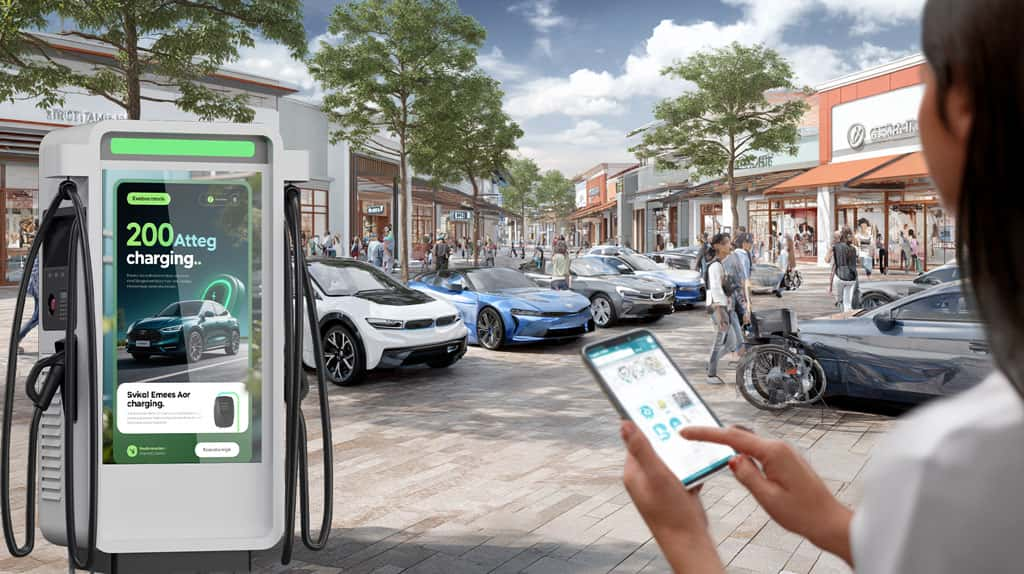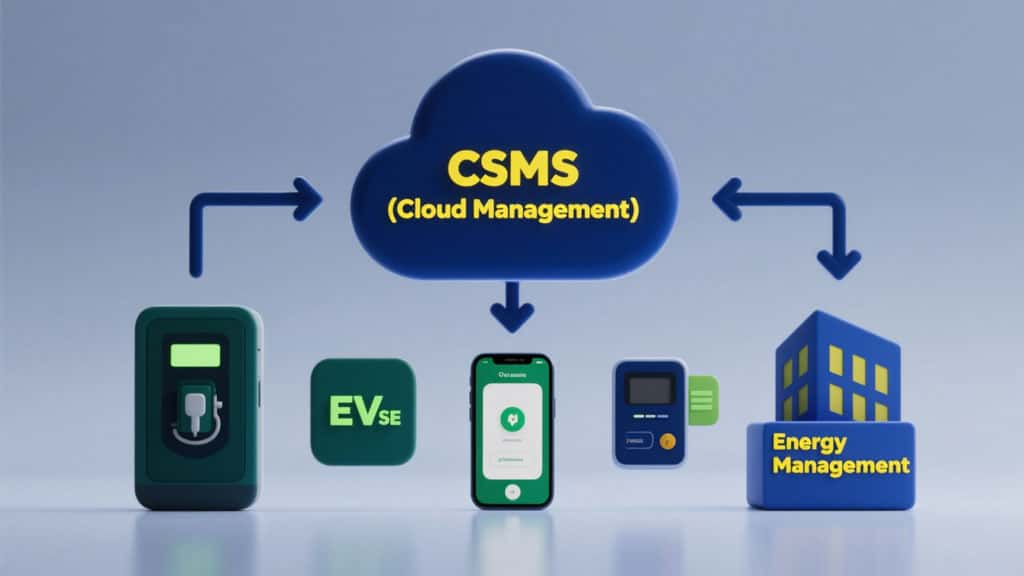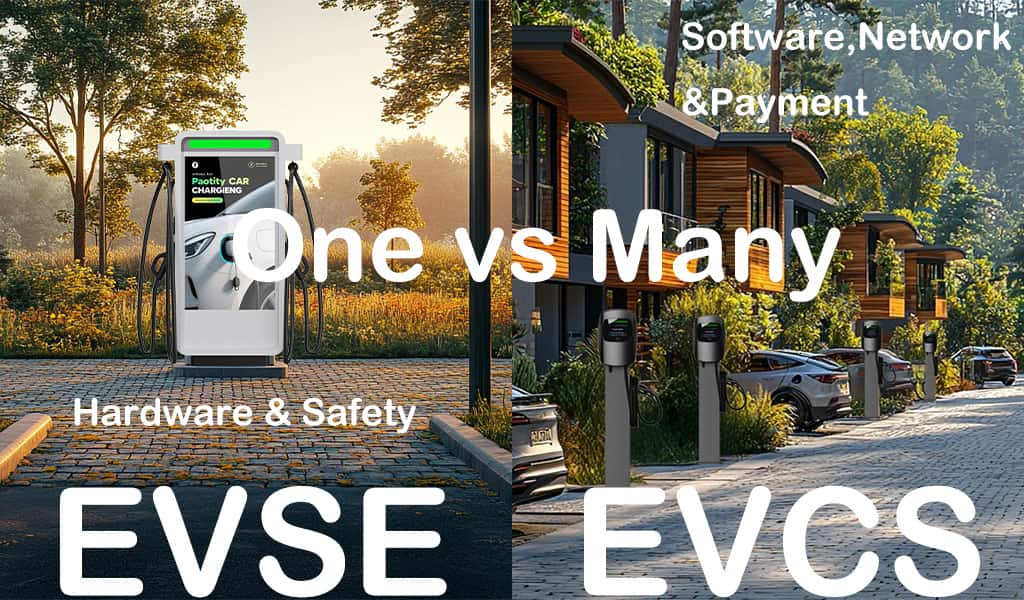Let's get straight to the point: No, EVSE and EVCS are not the same thing. While people often use the terms interchangeably, they represent two fundamentally different concepts in the world of electric vehicle charging. Understanding this difference is the first step to making smart decisions for your business or project.
Think of it this way: EVSE is the physical hardware, while EVCS is the complete, intelligent system.
We will break down this crucial distinction. We will explore what each term means, how they relate to each other, and why getting it right matters. As professionals in this field, we've seen confusion over these terms lead to costly mistakes in EV Charging Station Design. Our goal is to give you the clarity needed to invest wisely.
What is EVSE? The Essential Hardware for Charging

EVSE stands for Electric Vehicle Supply Equipment (EVSE). This is the official term, defined by the Society of Automotive Engineers (SAE) in their standard SAE J1772, for the equipment that safely delivers electricity to an electric vehicle.
In simple terms, an EVSE is the box on the wall or the pedestal you plug your car into. It's the tangible piece of hardware.
The primary job of an EVSE is not actually to "charge" the car. The actual charger (which converts AC power from the grid to DC power for the battery) is located inside the vehicle itself (this is called the on-board charger). The EVSE's main role is to act as a sophisticated safety device. As the U.S. Department of Transportation notes, it ensures that power only flows when it's securely connected to a vehicle.
Key Components of an EVSE:
• Connector & Cable: The plug and wire that connect to the car.
• Control Unit: The internal "brain" that communicates with the vehicle to determine the correct power level. This "handshake" is a critical safety feature.
• Safety Circuits: These include ground fault protection and systems to monitor for hardware failures, as outlined by standards from organizations like Underwriters Laboratories (UL).
An EVSE can be a simple, non-networked device, like many home chargers. You plug it in, and it works. It doesn't need an internet connection or a complex software platform to do its basic job of safe power delivery.
What is EVCS? The Intelligent Charging System

EVCS stands for Electric Vehicle Charging Station. This term describes the entire ecosystem, where one or more EVSEs are part of a larger, networked system. If EVSE is the hardware, EVCS is the hardware plus the intelligence.
An EVCS is what you interact with in most public or commercial settings. According to the National Renewable Energy Laboratory (NREL), a key feature of modern charging infrastructure is its ability to be remotely monitored and managed. This is the domain of the EVCS.
An EVCS takes the basic hardware (EVSE) and adds layers of technology on top.
Key Components of an EVCS:
• Multiple EVSEs: A station almost always has more than one charging point.
• CSMS (Charging Station Management System): This is the central software platform—the brain of the operation. It allows an owner to set pricing, monitor usage, and diagnose problems remotely.
• Network Connectivity: The station connects to the internet via Wi-Fi, cellular (4G/5G), or Ethernet.
• OCPP (Open Charge Point Protocol): This is a critical open-source language that allows the EVSEs to "talk" to the CSMS. The U.S. Joint Office of Energy and Transportation highlights OCPP as vital for creating an interoperable charging network.
• User Authentication & Payment: This includes RFID card readers, mobile apps, and credit card terminals that allow users to start and pay for a charging session.
The Core Difference: A Simple Analogy

To make it even clearer, let's use an analogy:
• An EVSE is like a single computer. It has all the necessary hardware to function on its own.
• An EVCS is like a computer network in an office. It connects multiple computers, manages them with a central server, controls user access, and tracks usage.
The single computer (EVSE) is useful, but the network (EVCS) provides the power of management, scalability, and commercial operation.
EVSE vs. EVCS: Head-to-Head Comparison
This table breaks down the key differences for easy reference.
| Feature | EVSE (Electric Vehicle Supply Equipment) | EVCS (Electric Vehicle Charging Station) |
|---|---|---|
| Core Concept | The physical device that delivers power. | The complete system providing a charging service. |
| Scope | A single piece of hardware. | Multiple EVSEs + software + network + services. |
| Primary Function | Safe power transfer. | Charging operations, management, and monetization. |
| Intelligence | Basic safety communication with the vehicle. | Networked, with remote management and smart features. |
| Key Standard | SAE J1772 (Hardware & Safety) | OCPP (Communication & Management) |
| Typical Example | A non-networked home charger. | A public charging location with multiple stalls and payment options. |
| Who Buys It? | Homeowners, electricians. | Businesses, property managers, fleet operators, CPOs. |
Why This Distinction Matters for Your Business
Using the right terminology is more than just being precise; it impacts your planning, budget, and long-term strategy.
• For Property Managers & Businesses: You are not just buying EVSEs; you are investing in an EVCS. Your focus should be on the management software (CSMS), network reliability, and user experience. A good EVCS allows for features like load balancing, which the California Energy Commission identifies as crucial for managing building energy costs.
• For Fleet Operators: You need an EVCS to manage your fleet's charging schedule, track energy consumption per vehicle, and minimize electricity costs through smart charging.
• For Electricians & Installers: You are physically installing the EVSE units. However, you must understand how they integrate into the larger EVCS network, including data cabling and connectivity requirements.
EVSE & EVCS Standards and Connectors
Both EVSE and EVCS rely on standardized connectors to ensure cars and chargers can work together. The variety of charger connector types can be confusing, but in North America, there are three main players:
1.J1772: The standard for Level 1 and Level 2 AC charging.
2.CCS (Combined Charging System): The standard for DC fast charging, which adds two large DC pins below the J1772 connector. Most non-Tesla EVs use this.
3.NACS (North American Charging Standard): Developed by Tesla and now being adopted by many other automakers. It is a compact connector that handles both AC and DC charging.
The U.S. government's NEVI (National Electric Vehicle Infrastructure) program requires federal funding recipients to include CCS connectors, ensuring broad compatibility.
From a Simple Device to a Smart Energy Hub
The journey from EVSE to EVCS is the story of the evolution of EV charging itself. It has moved from a simple electrical device to a sophisticated, networked energy hub.
• EVSE is the foundational hardware.
• EVCS is the intelligent system that unlocks commercial potential and grid integration.
Understanding this distinction is the first step toward building a successful and future-proof EV charging infrastructure. As technologies like Vehicle-to-Grid (V2G) become more common, the intelligence of the EVCS will be paramount.
Ready to build your EV charging infrastructure? Whether you need robust, reliable EVSE hardware or a comprehensive, turnkey EVCS solution, our expert team is here to help. Contact us today for a personalized consultation and let's power the future of mobility together. Your success starts with the right partner.
FAQ
1. Can I have an EVCS with just one EVSE?
Yes. Even a single, networked charger that is managed by a CSMS for public or commercial use is considered a charging station (EVCS). The key is the presence of the management system, not the number of chargers.
2. Is a home charger an EVSE or EVCS? Typically, a home charger is just an EVSE. It is a standalone device designed for safe power delivery without the need for networking, payment, or remote management. However, some "smart" home chargers have app-based controls, blurring the lines slightly, but they still lack the full suite of features of a commercial EVCS.
3. What is a CPO (Charging Point Operator)? A CPO is a company that operates and manages a network of EVCS. They are responsible for the maintenance, pricing, and software of the stations. Major CPOs include companies like Electrify America, EVgo, and ChargePoint.
4. Do I need OCPP for my EVSE? If it's a simple home charger, no. If you are building an EVCS and want the flexibility to choose your management software, then yes. The U.S. Department of Energy strongly advocates for open standards like OCPP to prevent being locked into a single vendor's proprietary system.
5. What is "smart charging"? Smart charging is a key feature of an EVCS. It allows the charging speed to be adjusted based on external factors, such as grid demand, electricity prices, or the needs of other vehicles at the station. This is impossible with a basic, non-networked EVSE.
Authoritative Sources
1. U.S. Department of Energy, Alternative Fuels Data Center: Electric Vehicle Supply Equipment - Comprehensive overview of charging infrastructure.
2. Society of Automotive Engineers (SAE International): J1772: SAE Electric Vehicle and Plug in Hybrid Electric Vehicle Conductive Charge Coupler - The official standard defining EVSE hardware in North America.
3. National Renewable Energy Laboratory (NREL): Electric Vehicle Charging Infrastructure Trends - Research and data on the state of the U.S. charging network.
4. Joint Office of Energy and Transportation: Minimum Standards for Federally Funded EV Infrastructure - Official document outlining requirements, including for OCPP.
5. Open Charge Alliance: About OCPP - The home of the Open Charge Point Protocol, explaining its purpose and benefits.
Media Contact
Company Name: Xiamen LinkPower Tech Co., Ltd.
Email: Send Email
Country: China
Website: https://www.elinkpower.com/





